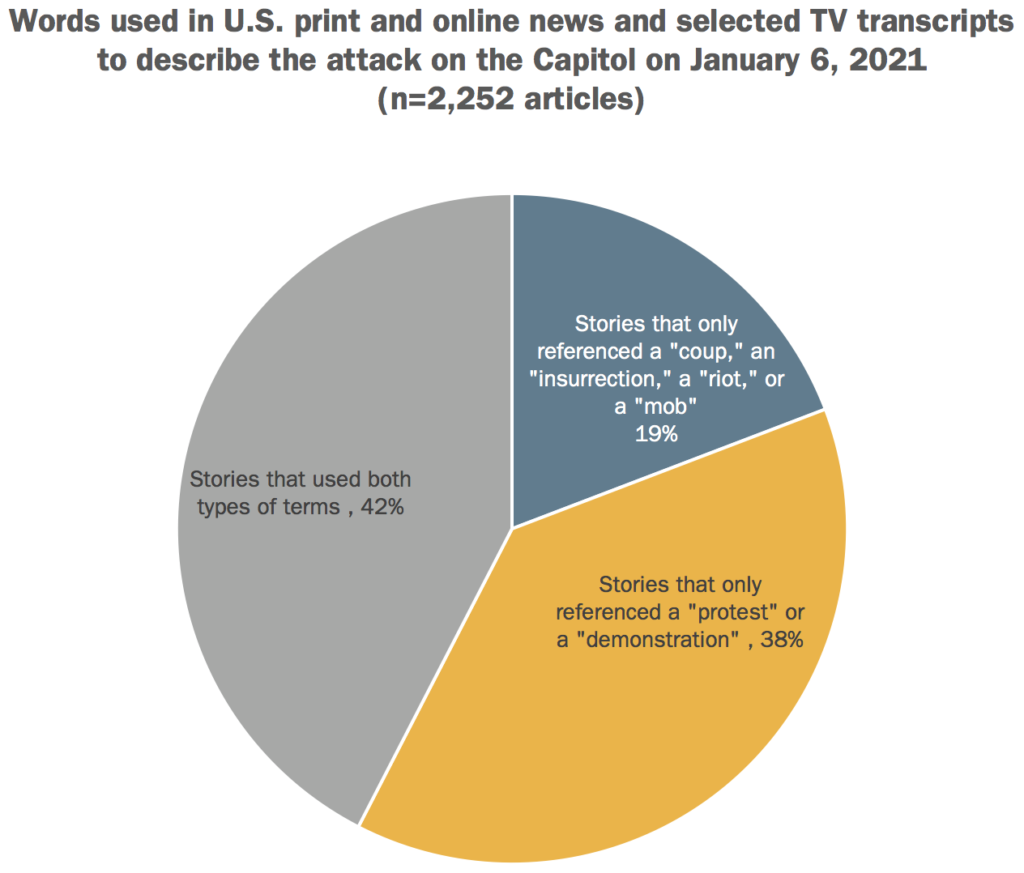Protest? Riot? Insurrection? Examining the news from January 6 — and where journalism goes from here
by: Pamela Mejia
posted on Friday, January 08, 2021
We’re collectively still reeling from the events of January 6, when armed supporters of Donald Trump, spurred on by comments made by the president himself, stormed the halls of Congress in an attempt to forestall the certification of president-elect Joe Biden’s win.
Though we all felt it, and are still feeling it, most of us weren’t at the Capitol. Instead, we were among the 300 million people who learned about the events through news coverage.
As rioters reached the House and Senate chambers, many U.S.-based news outlets described the uprising as a “demonstration” or a “protest.” However, they were swiftly taken to task by individuals and watchdog groups monitoring the events on social media. These bystanders encouraged journalists, instead, to use language that underscored the violence of the events and framed the attack as a treasonous and seditious act that the president himself led. On the 6th and in the days after, some commentators also highlighted stark differences between coverage of the Capitol attack and reporting on largely peaceful protests for racial justice in 2020.
A number of high-profile news outlets responded swiftly to the criticism, following the lead of international outlets that were, from the outset, direct in highlighting Trump’s role and labeling the violence in clear, uncompromising terms. For example, The New York Times recognized and named Trump’s obvious attempts to embolden racists rather than soft-pedaling his rhetoric and behavior, while The Washington Post‘s editor-in-chief told reporters to call the people storming the capitol a “mob,” and NPR began using terms like “pro-Trump extremists” and “insurrection.”
This got us thinking: What language were reporters and news outlets using to describe the armed attack on the Capitol? To find out, we searched the LexisNexis database for U.S. news (including print and online coverage, as well as selected TV transcripts).

We found that, of the more than 2,000 articles about the events published on January 6, over 80% included at least one reference to a “protest” or “demonstration.” By contrast, and despite some very prominent headlines, only 19% of stories framed the incident exclusively as an attempted coup, riot, mob, or insurrection. More than 40% of articles used both “protest” or “demonstration” terminology as well as more precise language to describe the violence.
Clearly, there’s more work to do to normalize language that unmasks white supremacy and describes the roots of the assault — and the threat it poses to democracy. This analysis presents a mere snapshot of coverage from the day of the attack; but, it offers insights as to steps journalists can take — and, indeed, are already taking — to ensure future reporting is as clear and accurate as possible.
Going forward, we hope to find that more outlets are:
1) Using precise language.
Euphemisms and other diluted language obscure the true nature of the problem, making it harder for audiences to understand what solutions are needed.*
2) Placing current events within historical context.
This includes being explicit about the roots of white supremacy and how they continue to manifest today. Journalists must continue to educate readers about structural racism and provide concrete examples in day-to-day news, not just in emergencies or during elections. That way, when crises do arise, news consumers’ learning curve will be smaller.
3) Naming who should be held accountable.
Reporters need to explain not only what happened but why, and who was involved. Using shorthand references or passive voice like “a demonstration was held” or “a mob formed” masks responsibility. When readers and viewers don’t know who is responsible, they are more likely to feel confused or overwhelmed. But when there is a clear target for action, chaos gives way to solutions and hope for change.
4) Lifting up the work of reporters and advocates of color.
Newsrooms must prioritize hiring staff who reflect the regions they cover and who have deep connections to their surrounding communities. Until we have diverse, inclusive newsrooms, audiences will continue to miss critical perspectives.
The days and weeks ahead are likely to challenge our democracy in unprecedented ways. The strength of that democracy demands participation; it depends upon the decisions we make individually and collectively — and the news media inform those decisions.
Now, more than ever, journalists must report the news with clarity and precision. They must bring history to the fore and frame events to help us understand what is unfolding and why.
We are counting on them.
*While we recommend highlighting the severity of this attack, we join advocates in urging caution about invoking the word “terrorism,” which may set the stage for counter-terrorism measures that have consistently harmed communities of color rather than addressing the roots of white supremacy.



